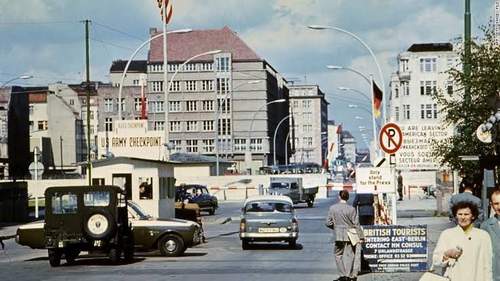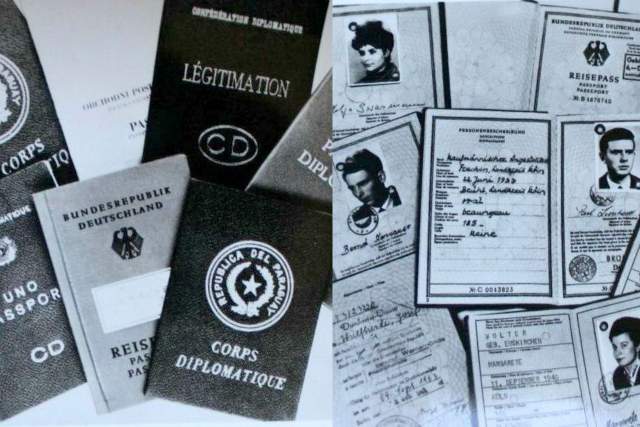For freedom one may even fake passports
For freedom, one may even fake passports – escaping East Germany.
For the German Democratic Republic (GDR), he was the number one public enemy. For many East Germans, this is their last resort. Dieter Jensch, together with Albert Schütz, bought almost 500 GDR citizens with fake diplomatic identity cards over the German-German border for twelve years after 1962. It all started by chance. During the 1962 winter holiday in Mittenwald, Schütz had a nightcap. With whom he was drinking, the bar owner made a name for himself with a CD paper that was exactly like a real diplomatic passport. The pseudo-document came from Munich, made by a smart businessman, especially for playboys who wanted to impress their girlfriends. Cost: 3000 marks. For freedom, one may even fake passports.

With the big letters “CD” on it. However, they did not stand for “Corps Diplomatique” (a member of the diplomatic corps), but for “Confédération Diplomatique”: It was the house card of a Munich playboy club. Jensch wanted a game card like that, too, and got it. Already on his return journey through the GDR, he pulled him out at the Töpen-Juchhöh crossing – and to his surprise, he was let through; he was even stamped with a GDR CD visa in his passport. Nearly unmasked at the border to West Berlin. “The border guard is surprised that only I had a diplomatic passport, but not the others in the car.” Endless waiting, then salvation: “You may drive. We kindly apologize for the delay.” Jensch: “Despite my bottomless carelessness, the mission CD had worked.”
From now on, Schütz and Jensch had a good trip on all trips to the GDR. First, they brought the relatives to the West via “Checkpoint Charlie.” Word of the action got around, and soon the diplomatic duo could hardly escape from orders: Brides, wives, uncles, and aunts escaped as embassy staff from all over the world.
Official bodies also showed interest in the refugee smugglers. German and Allied secret services were happy to pay between 6,000 and 10,000 marks to know that their contacts in the West were in danger. “After all, we had expenses. The passports had to be printed; we had a fleet of vehicles.” Two couriers, two drivers, and five different cars drove “sham diplomats” across the border. In Berlin at Checkpoint Charlie, but also about Hungary and Czechoslovakia. One of the most spectacular lock operations was to take place via Sassnitz to Sweden. A stocking manufacturer from Chemnitz wanted to get over his relatives; in Switzerland, an heir worth millions was waiting for him. But at the meeting point a nasty surprise: “The elderly aunt was sitting in a wheelchair. Who could take her away from being an embassy secretary?” The second attempt also failed – this time, they wanted to meet in Berlin and bring them over in the car without a turtleneck. But the old lady was asleep. For freedom, one may even fake passports.
Next day. Same spot. Now everybody came on time. Six people were taken in two stages.
To avoid attracting attention, Schütz and Jensch changed their luxury cars like shirts. Other fantasy products followed the Playboy passports, and finally, even UN ID cards. The Munich supplier soon became dispensable. The two commercial escape helpers had found a cheaper source of supply — a printing company in Spain, where they had introduced themselves as emissaries of the German Consulate General in Barcelona.
But Schütz and Jensch had not expected Spanish security authorities’ conscientiousness: During a routine check of the printing house for possible pamphlets against the Franco regime, secret police discovered the passports in October 1963. They immediately suspected a Communist network of agents and intercepted the two Berliners on the street at night.
For seven weeks, the illegal legacies squeezed the beds of the remand prison Castellón. Then they returned to Germany without a verdict: the Spanish security service had had “corresponding German offices” (Schütz) to insure the passport collectors’ activities, which were in reality anti-Communist. And Schütz remembers with pleasure how warmly he was received in Berlin after the Spanish affair by the present head of the State Office for the Protection of the Constitution, Senate Councillor Eberhard Zachmann.
At home, Schütz and Jensch smuggled on cheerfully and from then on used forgeries of diplomatic documents from Czechoslovakia, Turkey, and Pakistan. New place of printing: Greece.

The mission CD does not go unnoticed by the GDR leadership. The GDR issues an arrest warrant against Jensch; the Stasi has him under surveillance. “The comrades even drew up a plan to kill Jensch. In my Stasi file, I read that they wanted to put counterfeit money in my car and anonymously inform the police. The kidnapping was also planned.” But he had the right instinct, only sneaking out via Hungary and the CSSR.
The total turnover amounted to 1.5 million marks, which, according to Schütz, yielded sufficient dividends: “Of course, there is a nice piece of money left over for each of us, which we have invested well. However, the Berlin judiciary ordered by Bonn to punish the abuse of diplomatic immunity opened preliminary proceedings for forgery.
Both escape agents defended themselves, saying that they had lacked a sense of injustice: official authorities in West Berlin, they stated in the minutes, had assisted them in the criminal acts. But neither the public prosecutor’s office nor the 16th Grand Criminal Chamber of the Regional Court was inclined to hear the official witnesses. Schütz’s attorney Dietrich Scheid, served by bailiffs, invited liaison officers from German and American offices to the secret main hearing.
But they didn’t come. For example, the Federal Intelligence Service in Bad Godesberg could not deliver the summons to the witness Kaiser “because he is not known there.” The same information was given to the bailiff by American authorities for the witnesses Werner and Treskow. Only Senator Zachmann of the Office for the Protection of the Constitution could be found. However, he did not receive permission to testify from Mayor and Senator of the Interior Kurt Neubauer. Lawyer Scheid could no longer present applications for “identification of witnesses obviously protected by aliases”: The Criminal Court suspended the trial. The CD campaign ran until 1974. A total of 487 people were taken. After that, Jensch was a carpet dealer again and now lives as a pensioner in Berlin. For freedom, one may even fake passports
fluchthelfer
FAQ Passport History
Passport collection, passport renewal, old passports for sale, vintage passport, emergency passport renewal, same day passport, passport application, pasaporte passeport паспорт 护照 パスポート جواز سفر पासपोर्ट
1. What are the earliest known examples of passports, and how have they evolved?
The word "passport" came up only in the mid 15th Century. Before that, such documents were safe conducts, recommendations or protection letters. On a practical aspect, the earliest passport I have seen was from the mid 16th Century. Read more...
2. Are there any notable historical figures or personalities whose passports are highly sought after by collectors?
Every collector is doing well to define his collection focus, and yes, there are collectors looking for Celebrity passports and travel documents of historical figures like Winston Churchill, Brothers Grimm, Johann Wolfgang von Goethe. Read more...
3. How did passport designs and security features change throughout different periods in history, and what impact did these changes have on forgery prevention?
"Passports" before the 18th Century had a pure functional character. Security features were, in the best case, a watermark and a wax seal. Forgery, back then, was not an issue like it is nowadays. Only from the 1980s on, security features became a thing. A state-of-the-art passport nowadays has dozens of security features - visible and invisible. Some are known only by the security document printer itself. Read more...
4. What are some of the rarest and most valuable historical passports that have ever been sold or auctioned?
Lou Gehrig, Victor Tsoi, Marilyn Monroe, James Joyce, and Albert Einstein when it comes to the most expensive ones. Read more...
5. How do diplomatic passports differ from regular passports, and what makes them significant to collectors?
Such documents were often held by officials in high ranks, like ambassadors, consuls or special envoys. Furthermore, these travel documents are often frequently traveled. Hence, they hold a tapestry of stamps or visas. Partly from unusual places.
6. Can you provide insights into the stories behind specific historical passports that offer unique insights into past travel and migration trends?
A passport tells the story of its bearer and these stories can be everything - surprising, sad, vivid. Isabella Bird and her travels (1831-1904) or Mary Kingsley, a fearless Lady explorer.
7. What role did passports play during significant historical events, such as wartime travel restrictions or international treaties?
During war, a passport could have been a matter of life or death. Especially, when we are looking into WWII and the Holocaust. And yes, during that time, passports and similar documents were often forged to escape and save lives. Example...
8. How has the emergence of digital passports and biometric identification impacted the world of passport collecting?
Current modern passports having now often a sparkling, flashy design. This has mainly two reasons. 1. Improved security and 2. Displaying a countries' heritage, icons, and important figures or achievements. I can fully understand that those modern documents are wanted, especially by younger collectors.
9. Are there any specialized collections of passports, such as those from a specific country, era, or distinguished individuals?
Yes, the University of Western Sidney Library has e.g. a passport collection of the former prime minister Hon Edward Gough Whitlam and his wife Margaret. They are all diplomatic passports and I had the pleasure to apprise them. I hold e.g. a collection of almost all types of the German Empire passports (only 2 types are still missing). Also, my East German passport collection is quite extensive with pretty rare passport types.
10. Where can passport collectors find reliable resources and reputable sellers to expand their collection and learn more about passport history?
A good start is eBay, Delcampe, flea markets, garage or estate sales. The more significant travel documents you probably find at the classic auction houses. Sometimes I also offer documents from my archive/collection. See offers... As you are already here, you surely found a great source on the topic 😉
Other great sources are: Scottish Passports, The Nansen passport, The secret lives of diplomatic couriers
11. Is vintage passport collecting legal? What are the regulations and considerations collectors should know when acquiring historical passports?
First, it's important to stress that each country has its own laws when it comes to passports. Collecting old vintage passports for historical or educational reasons is safe and legal, or at least tolerated. More details on the legal aspects are here...
Does this article spark your curiosity about passport collecting and the history of passports? With this valuable information, you have a good basis to start your own passport collection.
Question? Contact me...

